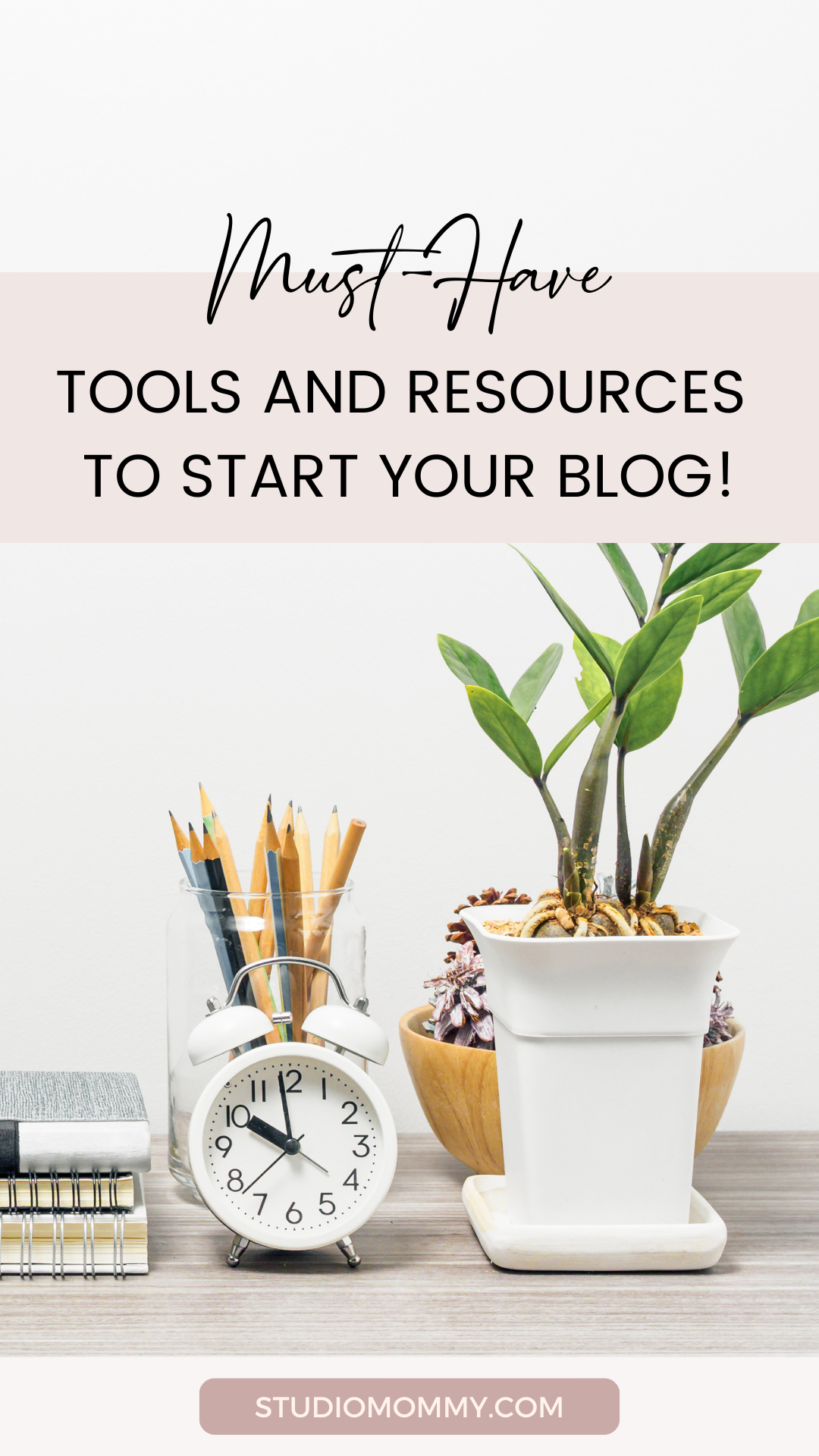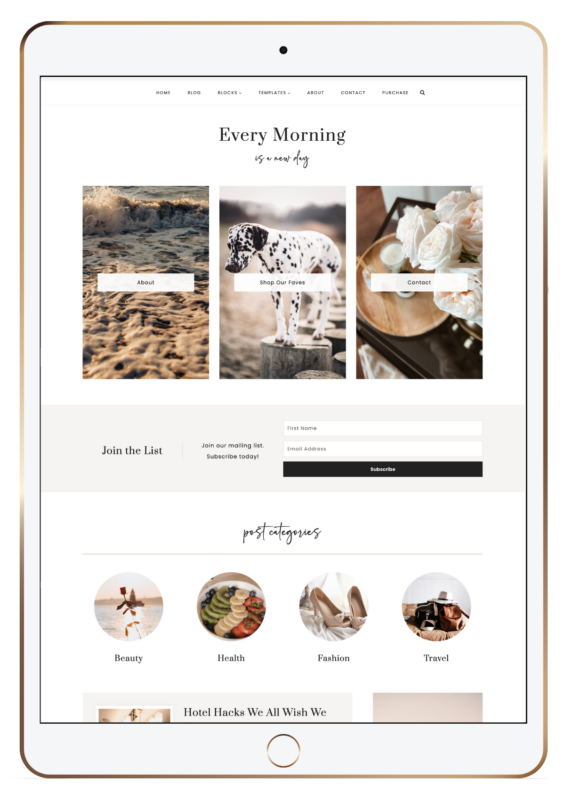Get Happiness Is A Magnet WordPress Theme at 60% Off. Use code SALEHAPPINESS at checkout!
Don't Miss A Thing!
Get The Goods!
Powerful Email Marketing
Drive powerful results with signup forms, landing pages, automations, sequences, real-time reporting, and more.
Looking for Something?
I know what it’s like to get started. As a blogger myself, I was in beginner’s shoes once. Starting as a new mom who hired a website designer, I quickly discovered that I wanted to make it easy, convenient, and simple for anyone to start their own boss babe empire or develop their passion.
READ MORE
Hey Y'all
Boss Babe
Templates
wordpress themes
view wordpress themes
10+ Must-Have Tools and Resources To Start Your Blog
When I first decided to start my blog and small business years ago, I was inexperienced and had no clue where to start.
I spent countless hours researching and reading every “How to Start a Blog” article, trying to learn everything I could. Needless to say, I could not find all the tools and resources in one place, which was frustrating.

There was so much information available from different sources which caused me to become frustrated and overwhelmed. I would have given anything to make the blog startup process easier by having all the things that I needed in one place.
I said all that to say this. My goal for you is to make the blog setup process easy and as stress-free as possible.
If you’re new to blogging, navigating the world of resources available to help you create and manage your blog can be overwhelming.
That’s why I have put together this blog post! So that you have everything you will need in the beginning stages of creating your blog all in one place!
These valuable resources can assist you with designing your website, promoting your content, and monetizing your blog. Start attracting readers and monetizing your blog in the early stages.
Why Tools and Resources Are Important For Bloggers
This list is meant to save you time and effort and allow you to get your blog up and running quickly. By doing so, you can then focus on the fun part! Creating content and growing your blog!
Not only will it help you create your blog but will help you be productive from the very beginning.
Keep in mind starting a blog years ago was a bit simpler than it is today. Today’s bloggers have to be mindful not only of creating helpful content but you have to consider things like SEO and keyword optimization to get their blogs in front of readers.
Another crucial part of blogging that tends to be overlooked is building community and networking with other bloggers. A great way to do this is by using resources such as blogging forums, communities, and social media groups. It provides a sense of support, inspiration, and growth opportunities.
Blog Name and Domain
Are you ready to start the blog of your dreams? Then keep reading!
First and foremost, I assume you have already thought about your blog name. If not, read “How to Come Up With a Blog Name.” This blog post will give you tips on how to come up with a blog name that reflects what you would like to blog about.
Once you have your blog name, you need to purchase a domain. For example, my domain is www.studiomommy.com. Your domain needs to be your blog name. I recommend purchasing your domain name through whatever hosting company you choose to use to host your blog. I discuss hosting services in the list of tools and resources below.
Tools and Resources To Start Your Blog
Some of the tools and resources mentioned below are my affiliate links. If you decide to purchase through those links, Studio Mommy will receive a small commish at no cost to you. Mama’s got to pay the bills so thanks for your support.
1. Content Management Systems (CMS) – My favorite platform for creating and publishing blog posts is WordPress. WordPress provides an easy-to-use interface for creating and publishing blog posts. It is the most popular platform because it has numerous helpful plugins that make creating a blog easy! You can read “How to Start a WordPress Website” for an easy-to-follow tutorial on how to set up your blog using the WordPress platform.
2. Hosting Service – A blog host is a company that provides the space on its servers for you to store your blog (i.e. SiteGround, Square Space, etc.) I have used several hosting services throughout the years, and trust me when I say SiteGround is hands down the best! You cannot beat their top-notch customer service. And believe me when I say, in the beginning stages of your blog (especially if you are not tech-savvy) you are going to have questions and tasks that you just have no idea how to complete. SiteGround will guide you through and not only answer your questions but also help you get past that one hurdle that is confusing you!
3. Choosing A WordPress Blog Theme – Choosing a blog WordPress theme can be a bit confusing. This blog post, “Choosing a WordPress Theme For My Blog” gives you tips on how to choose the appropriate blog theme for your niche.
I have several gorgeous and easy-to-customize WordPress blog themes for you to choose from. I have also created WordPress Theme Branding Bundles, which includes everything you need to get your blog up and running including graphic templates, planners, and branding kits! All in one, easy-to-find place!
4. Stock Photo Resources – Websites like Haute Stock and Elevae (formerly Social Squares) offer high-quality, images that bloggers can use to enhance their blog posts and make them visually appealing.
5. Blog Color Palette -While all of my blog WordPress themes come with fonts and a color palette, you may want to consider using any branding colors that you have determined beforehand. If you have not considered your branding colors, check out “How to Choose a Branding Color Palette For Your Blog.” I also have numerous color palette mood boards that you can take a look at to help you choose your color palette.
6. Coordinating Fonts – My WordPress blog themes also come with coordinating font styles, however, if you have determined which fonts you would like to use, you can certainly change them. If you have not decided on fonts, then I recommend you to take a look at Creative Market (affiliate). There you can find the perfect custom font to use for your blog.
Another font resource is Google Fonts. Google allows you to choose a font and visually see and test the font!
I have also put together several font combinations to help and inspire you! Take a look at “My Favorite Font Combinations” to see pairing font examples.
7. Legal Documents – It is important to make sure that your blog is legal. By that, I mean having the required documentation like privacy policies and terms and conditions. The Contract Shop is the perfect place to acquire all of the legal documentation needed to protect your blog.
8. Blog Speed Performance – In a world where everyone is in a hurry, your blog speed performance is of the utmost importance! You can use the Google Page Speed tool to see how Google views your site. This will tell you if your blog is running slow and what you can do to improve your speed performance.
You can also use GTmetrix which will show you how your site performs as far as loading speed. It also tells you why it’s slow, and helps you optimize for faster page loads.
9. E-commerce – If you plan to sell products or services on your blog, it’s important to have a platform that makes the customer journey as smooth and effective as possible. Here at Studio Mommy, I use ThriveCart. I not only sell products on my website but I also have an Etsy shop.
10. Analytics Tools – Platforms like Google Analytics and Jetpack for WordPress provide valuable insights into blog traffic. These insights include page views, referral sources, and user demographics. All of these help bloggers measure the success of their content and identify areas for improvement.
11. Email Marketing Tools – Email marketing should be a big part of your marketing strategy! Creating an email list is the best way to connect with your customers, as well as potential customers. Check out “How To Grow Your Email List” for valuable tips and information.
Here at Studio Mommy, I have been a huge fan of ConvertKit. This platform helps bloggers build and manage their email lists. It also allows bloggers to engage with their audience through newsletters and promotional campaigns. And it is user-friendly! I have used other platforms like MailChimp, and they were confusing and just not easy to use.
12. SEO Tools – Plugins like Yoast SEO for WordPress provide bloggers with optimization suggestions to improve their search engine visibility and increase organic traffic. Plugins are the number one reason why I recommend the WordPress platform (See #1 above). Plugins can help you create your E-commerce store, and provide other valuable functionality tools for your blog without having to be tech-savvy.
If you have no clue what SEO is referring to, then you can read “The Mummy’s Blogger’s Guide to Search Engine Optimization.” You can also check out “SEO Tips to Rank and Rock.”
13. Affiliate Marketing Networks – Networks like Amazon Associates and ShareASale allow bloggers to monetize their blogs by promoting products and earning commissions on sales generated through their affiliate links.
14. Monetization Platforms – Platforms like Google AdSense and Mediavine allow bloggers to monetize their blogs through display ads. This enables you to generate passive income.
Other Helpful Resources
Phew, I know that was a lot. After you have your blog set up and ready to share with the world, be sure to read these two blog posts. I share valuable tips on what to do before and after launching your blog.
Ten Things You Should Do Before Launching Your New Blog/Website
Six Things To Do Immediately After You Launch Your Blog/Website
You can also check out my Blogging Tips page where there are posts all about blogging!
I sincerely hope this list of tools and resources to start your blog encourages you to start your blogging journey! I know all too well that having access to useful tools and resources can save you time and money. Not to mention, help you reach your blogging goals faster and more effectively.
If you have any questions, please feel free to reach out or comment below this blog post.
Hi 🤗! I want to help you create a website you love 💕 where you are excited to work or blog. Come see our easy to use, feminine, beautiful designs.
WordPress Themes
You’ve put in the work to make awesome content, now it’s time to dress up your site with a stunning design.

facebook
twitter
pinterest
share & save:
xoxo, april